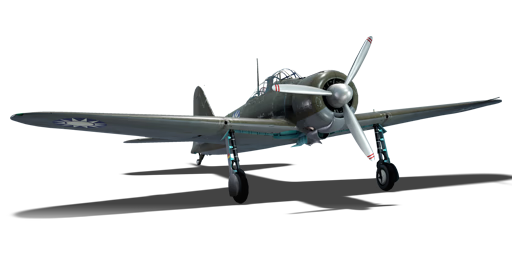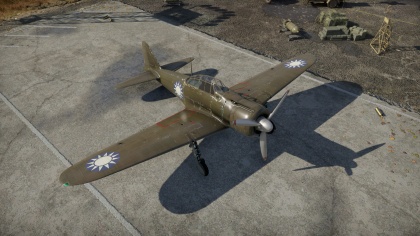A6M2 (China)
Contents
Description
The ␗A6M2 Reisen is a premium rank Chinese fighter
with a battle rating of (AB), (RB), and (SB). It was introduced in Update 1.93 "Shark Attack".
General info
Flight performance
This aircraft is a copy from the A6M2 from the Japanese tech tree, it has really good turning and maneuverability, is able to accelerate fast, has a good climb rate and is known for being the best turn-fighter at its BR with the cost of being very weak in terms of armour protection against enemy fire. This aircraft also has a slow top speed, but is still very competitive with other fighters at its BR.
| Characteristics | |||||||
|---|---|---|---|---|---|---|---|
| Stock | |||||||
| Max Speed (km/h at 4,400 m) |
Max altitude (meters) |
Turn time (seconds) |
Rate of climb (meters/second) |
Take-off run (meters) | |||
| AB | RB | AB | RB | AB | RB | ||
| 491 | 477 | 17.7 | 18.1 | 10.2 | 10.2 | 175 | |
| Upgraded | |||||||
| Max Speed (km/h at 4,400 m) |
Max altitude (meters) |
Turn time (seconds) |
Rate of climb (meters/second) |
Take-off run (meters) | |||
| AB | RB | AB | RB | AB | RB | ||
| 531 | 510 | 16.8 | 17.0 | 17.4 | 13.3 | 175 | |
Details
| Features | ||||
|---|---|---|---|---|
| Combat flaps | Take-off flaps | Landing flaps | Air brakes | Arrestor gear |
| ✓ | ✓ | ✓ | X | ✓ |
| Limits | ||||
|---|---|---|---|---|
| Wing-break speed (km/h) |
Gear limit (km/h) |
Combat flaps (km/h) |
Max Static G | |
| + | - | |||
| 510 | ~12 | ~7 | ||
| Optimal velocities | |||
|---|---|---|---|
| Ailerons (km/h) |
Rudder (km/h) |
Elevators (km/h) |
Radiator (km/h) |
| < 270 | < 420 | < 410 | > 324 |
| Compressor (RB/SB) | ||
|---|---|---|
| Setting 1 | ||
| Optimal altitude | 100% Engine power | WEP Engine power |
| 3,400 m | 950 hp | 1,075 hp |
Survivability and armour
There is close to no survivability on this aircraft. A stray .50 cal can burn down your plane. The structure of the plane is good, except that the plane burns in the front, quickly knocking out the pilot. It has armour behind the pilot, however.
Armaments
Offensive armament
The A6M2 (China) is armed with:
- 2 x 20 mm Type 99 Model 1 navy cannons, wing-mounted (60 rpg = 120 total)
- 2 x 7.7 mm Type 97 navy machine guns, nose-mounted (680 rpg = 1,360 total)
Suspended armament
The A6M2 (China) can be outfitted with the following ordnance:
- Without load
- 2 x 60 kg Navy Type 97 Number 6 bombs (120 kg total)
Usage in battles
The best tactic to use in this aircraft is to sneak up behind your enemies and use your excellent turn rate to your advantage, something that most other fighters don't have at the BR. The most dangerous enemies in this aircraft come from above, Boom and Zoomers will reign fire from above if your are not careful.
Manual Engine Control
| MEC elements | ||||||
|---|---|---|---|---|---|---|
| Mixer | Pitch | Radiator | Supercharger | Turbocharger | ||
| Oil | Water | Type | ||||
| Controllable | Controllable Not auto controlled |
Controllable Not auto controlled |
Controllable Not auto controlled |
Separate | Not controllable 1 gear |
Not controllable |
Modules
| Tier | Flight performance | Survivability | Weaponry | ||
|---|---|---|---|---|---|
| I | Fuselage repair | Radiator | Offensive 7 mm | ||
| II | Compressor | Airframe | New 7 mm MGs | 9 in (mod30) | |
| III | Wings repair | Engine | Offensive 20 mm | ||
| IV | Engine injection | Cover | New 20 mm cannons | ||
Pros and cons
Pros:
- Excellent turn rate
- Excellent roll rate
- Superior climb rate up to 4,500 m
- Decent cannon armament
- Nimble, your opponents will have a hard time hitting you
- Extremely maneuverable
- Very good at catching enemies off guard
- Can out turn almost all enemies it can face
- Tail hook enables it to land on carriers
- Very short takeoff distance
Cons:
- No armour and no pilot protection
- Limited 20 mm cannon ammo
- 7.7 mm machine guns don't really do any significant damage
- Guns have different trajectories, you need to get really close to targets to be effective
- Attacking bombers is one of the worst jobs for the Zero, as it is easily damaged by their gunners
- Although it can carry bombs, it's just absurd to equip them to the Zero
- Slow in a straight line
- Strictly limited to the air-to-air role, although it performs exceptionally in it
- No self-sealing fuel tanks and the plane is littered with fuel tanks, will ignite and burn to death quite often
- Can easily be countered by just doing simple Boom & Zoom as the Zero lacks adequate energy retention
- Low dive speed, and easily compressed in a dive
- Has lots of bars inside the cockpit, limiting visibility
- Prone to ripping at high-speed manoeuvres
History
In 1937, the Imperial Japanese Navy's Koku Hombu (Aviation Bureau) issued the "Planning Requirements for the Prototype 12-shi Carrier Fighter" to the Mitsubishi Kokuki K.K. (Mitsubishi Aircraft Company Ltd.) and the Nakajima Hikooki K.K. (Nakajima Aeroplane Company Ltd.), requiring designs for a new fighter to replace the Mitsubishi Type 96 Carrier Fighter (A5M). The requirements were extremely challenging: manoeuvrability equal to or better than the Type 96 fighter, heavier armament including 20 mm cannons, exceptional rate-of-climb to intercept bombers, a range of at least 1,010 miles with a normal fuel load to escort bombers, a take-off distance of less than 230 ft into a 30 mph wind, landing speed of less than 67 mph, and a top speed better than 310 mph.
Nakajima soon bowed out in the face of such seemingly impossible requirements, but Jiro Horikoshi, who had previously designed the A5M, and his design team at Mitsubishi were undeterred. In addition to the already demanding requirements of the IJN, Horikoshi was also limited by the relatively weak engines that the Japanese aviation industry had to offer at the time. Selecting the lighter but less powerful Mitsubishi Zuisei-13 ("Holy Star"), which had a rating of less than 900 hp, the Mitsubishi team strove to design the lightest possible airframe around the engine, but that was still strong enough to withstand carrier operations and carry enough fuel and weapons to be an effective fighter. To this end, they were fortunate that the Sumitomo Metal Company had just finished developing a new strong zinc-aluminium alloy known as Extra Super Duralumin (ESD), allowing thinner sheets to be used for the skin of the fighter without loss of strength. However, they also had to dispense with self-sealing fuel tanks and any sort of armour for the pilot. The relatively light but less powerful Oerlikon FF 20 mm cannon was chosen as the fighter's main armament, produced in Japan as the 20 mm Type 99. A large wing ensured a low wing loading to ensure maneuverability but limited the diving and level speeds.
The first flight of the Prototype 12-shi carrier fighter (later designated A6M1) took place on 1 April 1939. The next month, the IJNAF expressed its intentions to switch from the Zuisei-13 to the more powerful Nakajima Sakae-12 ("Prosperity") 14-cylinder radial engine, and it was first installed on the third prototype. This prototype would be designated as the A6M2, and it was with the Sakae radial engine that almost every model of the A6M fighter family would go to war. Testing of the first three A6M prototypes took place later that year. The A6M1 was able to meet all but the maximum speed requirements, but the Sakae-equipped A6M2 exceeded them at 331 mph. On 31 July 1940, the Mitsubishi A6M2 was formally accepted by the IJNAF as the Type 0 Carrier Fighter Model 11.
The A6M2 proved itself during combat in China. The aircraft also performed well during its carrier trials. One problem that did quickly arise was its ability to fit on carrier's elevators. The solution was to have the A6M2 fold its wing tips to avoid damage. This reduced the total wingspan by 20 inches. This change required it to have a new designation. The aircraft was put into production in November of 1941 and a total of 740 were constructed. This particular variant was code-named "Zeke 21" by Allies.
Media
Excellent additions to the article would be video guides, screenshots from the game, and photos.
See also
- A6M2 - Original version in the Japanese tree
External links
Paste links to sources and external resources, such as:
- topic on the official game forum;
- encyclopedia page on the aircraft;
- other literature.
| Mitsubishi Company (三菱商会) | |
|---|---|
| Fighters | A5M4 · Hagiri's A5M4 |
| A6M2 mod. 11 · A6M2 · A6M3 · A6M3 mod. 22 · A6M3 mod. 22Ko · A6M5 · A6M5 Ko · A6M5 otsu · A6M5 Hei · A6M6c | |
| A7M1 (NK9H) · A7M2 | |
| J2M2 · J2M3 · J2M4 Kai · J2M5 · J2M5 (30 mm) | |
| Hydroplanes | F1M2 |
| Interceptors | Ki-83 · Ki-109 |
| Bombers | G4M1 |
| Ki-21-Ia · Ki-21-I hei · Ki-67-I Ko · Ki-67-I otsu | |
| Jet Fighters | Ki-200 |
| Captured | ▃A6M2 · ␗A6M2 |
| See also | Mitsubishi Heavy Industries, Ltd. (Post-War) |
| China fighters | |
|---|---|
| British | ␗Gladiator Mk I |
| French | D.510C |
| Japanese | ␗A6M2 · ␗Ki-27 otsu · ␗Ki-43-III ko · ␗Ki-44-II hei · ␗Ki-61-I otsu · ␗Ki-84 ko |
| American | CW-21 · Hawk III · P-66 · ␗P-40E-1 · H-81A-2 · ␗P-43A-1 |
| ␗P-47D-23-RA · ␗P-47D-30 · ␗F-47N-25-RE · ␗P-51C-11-NT · ␗P-51D-20 · ␗P-51K | |
| Soviet | ␗I-15bis · ␗I-153 M-62 · ␗I-16 Chung 28 · ␗I-16 type 5 · ␗I-16 type 10 · ␗I-16 type 17 · ␗La-11 · ␗La-9 |
| China premium aircraft | |
|---|---|
| Fighters | ␗A6M2 · D.510C · ␗F-47N-25-RE · H-81A-2 · Hawk III · ␗Ki-45 hei/tei · ␗Ki-84 ko · ␗P-51C-11-NT |
| Jet fighters | Shenyang F-5 · J-7D |
| Strike aircraft | A-5C · ␗F-84G-31-RE |





